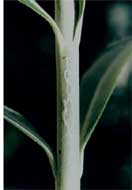CITRUS PEELMINER
MARMARA (new species)
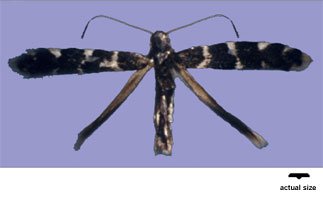
Situation: Citrus peelminer has been reported mining the peel of citrus fruits in the southwestern U.S. since the early part of the twentieth century. The earliest known collection from a mined orange peel collected 23 July 1915 from Pasadena, California. The peelminer is considered to be native leafminer normally attacking willow, which has undergone a host shift to various non-native plants including citrus and oleander. On citrus, larvae almost always attack the fruit and rarely infest leaves.
Damage: Larvae of peelminer form serpentine mines on the fruit of citrus. Grapefruit, lemon and lime are most susceptible to damage but the peelminer attacks all varieties, as well as stems of oleander, avocado fruit, stems of cotton and leaves, and stems of willow. Under heavy infestations, peelminer will mine the leaves of citrus, but this is rare. Mines are serpentine and lack any associated frass line. Eggs are laid directly on fruit. Pupation occurs outside the mine in cracks or crevices in the tree within silken cocoons ornamented with small spheres. Peelminer has a short developmental time and as many as 6-13 generations per year can occur.
More hosts of Citrus Peelminer in California PDF file, 251 KB
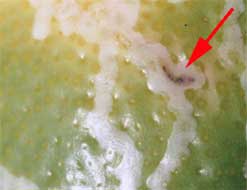
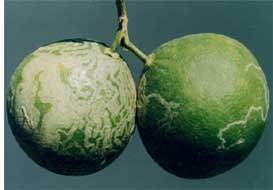
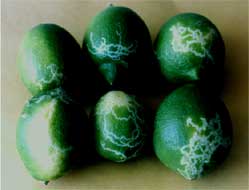
Economic Impact: Citrus peelminer causes direct damage to the peel of grapefruit, and although damage is cosmetic, as few as 2-3 mines per fruit can render fruit unacceptable for the fresh market. In 1995, a severe infestation in the Coachella Valley resulted in the loss of 80-90% of grapefruit in some groves. The peel of the fruit can become completely mined and take on an overall blistered appearance.
Distribution: Citrus peelminer has been reported as an economic pest in California, Arizona and Cuba, although it has been noted (but never accurately identified and may be another species) in low numbers in Texas and Florida. The peelminer is found throughout southern California as far north as Tulare County, but only appears to be a sporadic pest in desert regions.
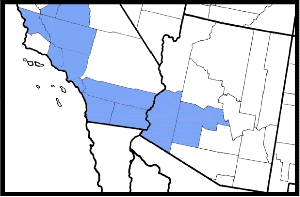
Control: One native gregarious eulophid wasp, Cirrospilus coachellae, provides good to excellent control of peelminer populations. The parasite pupates in the mine and can be seen through the epidermis as a series of small naked black pupae surrounded by black dots (fecal pillars). Often, several exit holes surround the remains of pupae. More than one generation of parasites is produced for each host generation and from 2-7 parasitoids develop on each host killed, allowing for rapid expansion of the parasite population. In average years, peelminer populations are highest during summer months when fruit are growing, with numbers declining and parasitism increasing to 60-90% by late August. Applications of pesticides have not been a successful control strategy. Peelminer is active through winter, but parasitism remains high. The cultural practice of removing all mined fruit from trees 3-4 weeks before new fruit is set in spring is the best means of reducing outbreak populations of the moth in the following year.
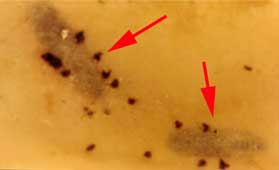
Print version originally prepared by the
Citrus Research Board, California Department of Food and Agriculture and
the University of California Exotic Pest Management Center. Photographs
courtesy of Marta Guillen and Eldon Reeves.
Web adapted by J. Jones, University of Arizona.
Questions concerning Citrus Peelminer in Arizona can be addressed to: peterell@ag.arizona.edu
Cotton Insects | Cotton Insect Pubs | Cotton Insect Data | Stickiness | Advisories | Pesticides | Photos
Home | Cotton | All Insects
document located at: http://cals.arizona.edu/crops/cotton/insects/other/peelminer.html
Copyright © 2001 University of Arizona,
College of Agriculture and Life Sciences
Webmaster: Al Fournier (acis@ag.arizona.edu)
